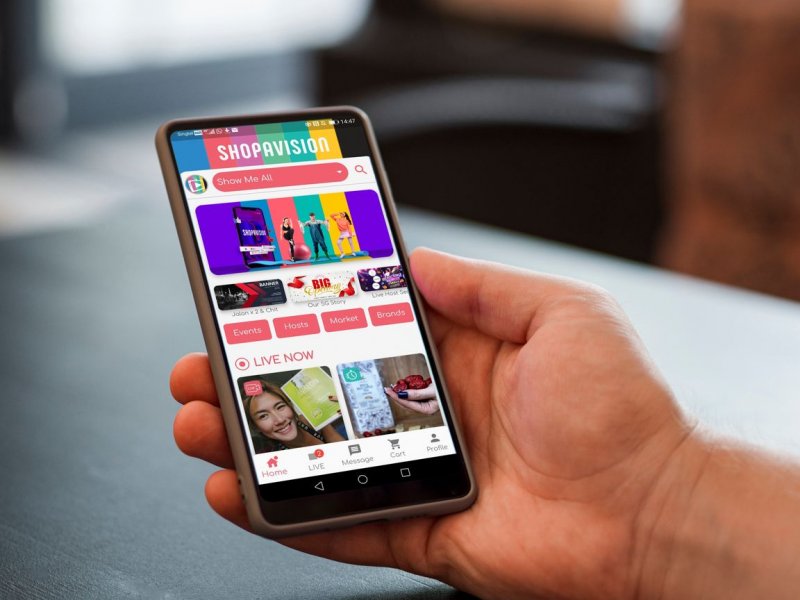The next big thing in retail trends is livestreaming e-commerce.
If you’re still skeptical, scoffing every time you scroll through a live streaming session on Facebook or Instagram, consider this: In China, popular live streaming host Viya started selling in 2012 and shot to fame in 2016 when she was approached by the Taobao Live platform. In 2019, she made a US$385 million profit in a day (Single’s Day 2019).
According to an article on supchina.com, Viya has managed to draw over 37 million viewers to tune in to her live streaming show, which is part variety show, part infomercial, and part group chat. Simply put, the numbers are staggering, proving that it could very well be how most of us will be buying certain products in the immediate future.

Rachel Pang. Photo credit: Media Group
In Singapore, livestreaming e-commerce has slowly picked up over the years (remember Lerine Yeo who made S-hooks so popular in 2018?), but it was Rachel Pang who took it to the next level. She is the brain behind Shopavision, the only independent mobile-first livestream shopping media app in the country.
In a nutshell, the platform is built to empower retailers and B2C merchants with a self-serve Live Stream Commerce business tool that they can fully control. Launched in August 2020, Shopavision is integrated with live stream video technology, e-commerce capabilities, customer profiling, data analytics and native payments.
“Livestream commerce is becoming an increasingly popular sales channel for merchants to build their brands and connect with customers,” shares Pang. “It is extremely prevalent in countries like China, but it is still relatively untapped in Singapore.”
Discovering the entrepreneurial spirit
Pang’s entrepreneurial spirit manifested itself early as she worked towards financial independence. The 37-year-old mother of three reveals: “My family is not well off so I decided to stop taking pocket money from my parents when I graduated from secondary school. I started working part time jobs at retail boutiques, ranging from menswear and women’s fashion to beauty and skincare, all while juggling my tertiary studies.”
“Even then, I had the opportunity to become a retail manager, manning an entire shop and clocking best sales at only 17 years old. Thereafter, I ventured into the events and entertainment industry. Working as a talent/model, I was involved in many promotional events and activities, and even landed an opportunity to be contracted to do talent and event management for a beverage company.”
After leaving school, Pang started her full time career at various places: A local events company, an Australian marketing agency, and even did marketing and communications at a country club. She adds: “Later on, my husband was running a traditional design agency and due to a partnership split, we made the decision to come together and set up a new, full service integrated marketing agency that specializes in digital marketing. Back then, we were one of the pioneer agencies in Singapore to have a full digital team. We grew in strength, keeping up with trends and customizing solutions for clients in the Southeast Asia region and we have been managing the agency until today.”
The road to Shopavision
It was through Pang’s digital marketing agency that an “a-ha moment” presented itself. In their line of work, they constantly observe the US and China market’s advancement in digital—from the dot coms and e-commerce to new retail and livestream commerce.
“I fly to China quite often and have seen how they have evolved at phenomenal speed and observed how livestreaming was done there and on platforms like Taobao Live. I was wowed at the new retail concept, how they built their livestream commerce infrastructure and business model, and how local sellers run their entire business online, so much so that even traditional farms in the countryside could also sell their goods instantly via mobile livestreaming,” says Pang.
“As an industry professional and practitioner, I have always been looking out for new solutions that can help our clients, marketers, and business owners. Together with the success of home shopping TV networks in America and other countries, I believe mobile-first livestream commerce just might be the solution that we can build to empower merchants at large, giving them accessible, affordable, and sustainable means to drive marketing and sales.”

In 2018, Shopavision was born. “We conceptualized Shopavision two years ago and registered the business, but realized it was too early for merchants in Singapore to adopt this new solution. Out of 10 clients and friends we spoke to, only one or two briefly understood what livestreaming was, but were certainly not ready to have anything to do with it. We decided timing wasn’t right yet and it would be an uphill task to educate the market. Thus, we decided to shelve the idea.”
“But a year ago, when Facebook and Instagram Live started gaining popularity in Singapore, we knew that the time was right. We put our Shopavision business plan together and presented it to IMDA. They believed in us and that livestream commerce fits well in the new media vertical, which was in line with the national digitalization push for businesses. IMDA gave us a grant and we officially started developing the app. Back then, we were not expecting a pandemic like Covid-19 to happen, but you could say it was a catalyst—all of a sudden, this year, livestream selling became the new light that people are turning their attention to.”
Challenges that keep us going
“Livestream commerce is so new, even to us,” admits Pang. Although they have the business and digital development know-how, they were challenged in building the entire app and system on limited funds and a very lean team. “However, having a strong founding team, which includes my two partners (the COO and CTO), allows us to make fast and sound decisions to move forward. Staying clear-headed on what we want to achieve, being objective and focused also helps us overcome these challenges, keeping us motivated to pursue what we set out to do.”
Zooming in on the details, Shopavision is designed to be a self-serve platform that merchants can manage themselves. According to Pang, “We don’t earn big bucks compared to agency projects, but we are looking at scale. Keeping the usage fees as low as possible, we charge by bandwidth account usage and percentage off of transaction fees. We are also looking to earn from supporting services, such as account management, livestream content production, advertising and more.”
Then there’s the issue of democratization. While Singapore is a multi-cultural country, a quick glance at a livestream selling session will tell you that it is still largely targeted towards a Chinese audience. “We can’t cater to all at one time,” admits Pang. “For a start, we decided to lean towards Chinese consumers as they are the majority race here. However, English is also a key language that some of our hosts use, alongside Singlish that is peppered with other languages and dialects. To achieve democratization and be a truly localized platform, we are also growing a family of livestream hosts from all races and we welcome all local merchants onboard. Through this, we can cater to different groups of local audiences, and even for overseas audiences once we scale beyond Singapore’s shores.”
In a media release shared by Shopavision, it shows that only 15% of people in Singapore consume live streaming content, which is a far cry from China’s 90%. While still in its infancy in Singapore, Pang is seeing an evident and promising increase in awareness and consumption of livestreaming content. “As a result of our efforts, we hope to fast track the acceptance of livestream commerce, making it an integral part of our lifestyle. At the same time, we will empower more merchants to understand and master how they can run their business on Shopavision using the power of livestreaming by providing them with not just the system, but also the consultancy, ideas, resources, and support to do better.
“We want to make ‘retailtainment’ a reality. To be honest, businesses in Singapore have been more traditional and are slower when it comes to adopting new digital trends and solutions. It’s that ‘wait and see’ attitude that holds them back. With the exponential growth seen in China and the livestream market valued at US$63 billion at the end of 2019, I truly believe that we can see relative growth in Singapore over the next few years as businesses seek more efficient ways of doing marketing and driving sales.”
A version of this article first appeared on Portfolio.





